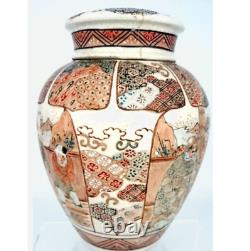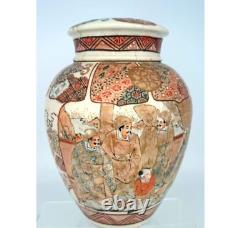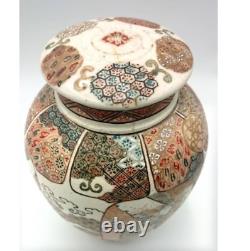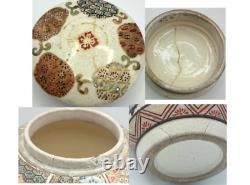Vintage / Antique Japanese Satsuma Ware Ginger Jar






Vintage / Antique Japanese Satsuma Ware Ginger Jar. The Ginger Jar was parT of a collection of Japanese Satsuma ware along with three vases of a very similar in style and decoration. One of the vases contained an old note dating the vase circa 1860 - 1870.
This is the beginning of the Meiji period (1868 -1912). It is possible that the Ginger Jar dates from this period.
Satsuma ware was first made in the 16th Century in Satsuma Province of Japan by Korean potters. The Paris Exposition in 1867 introduced Satsuma ware to the West. Satsuma ware became one of the most recognized exports of Japan it became an important source of funding in the Meiji period supporting the change from feudal society to an international industrialised nation. The features of Satsuma ware are ivory coloured background and a fine clear crackle glaze which is intentionally produced by the pairing of glaze and heat. The hand painted decoration is "on glaze". The Ginger Jar made of traditional earthenware has these characteristics. The decoration style indicates that the Ginger Jar was produced for export where popular designs for the Western market included mille-fleur, panels of Japanese scenes such as pagodas, cherry blossom, and beautiful ladies and noblemen in traditional dress. The scenes on the Ginger Jar show expressive and animated Japanese figures in traditional dress.The boys have had their front hair cut in the coming of age maegami-dachi ritual and the men also appear to have their heads shaven in the Samurai tradition. The landscape is two dimensional which is typical of earlier export pieces inspired by the popularity of Japanese prints of the day. Size Height 7.5 inches including lid. Width 5.5 inches Max.
The Ginger Jar displays well despite showing signs of use and wear commensurate with its age. Please see photographs for visual details. A delightful, engaging and beautifully decorated Japanese Ginger Jar. The artist skilfully captures the character and interaction of the figures in an animated scene.

